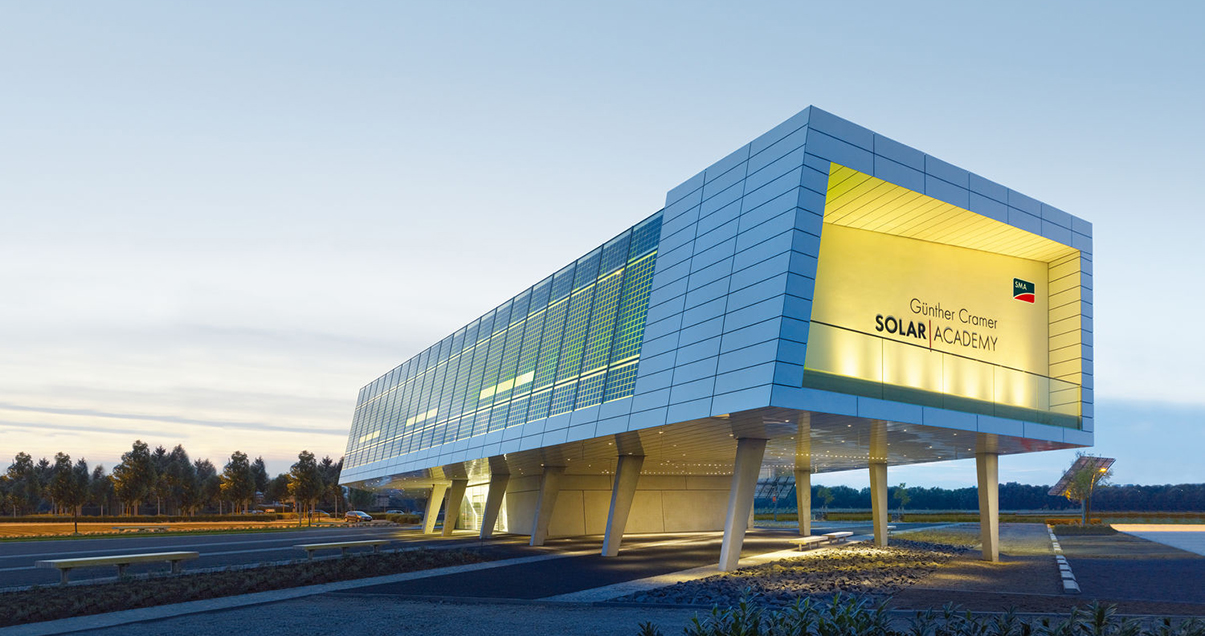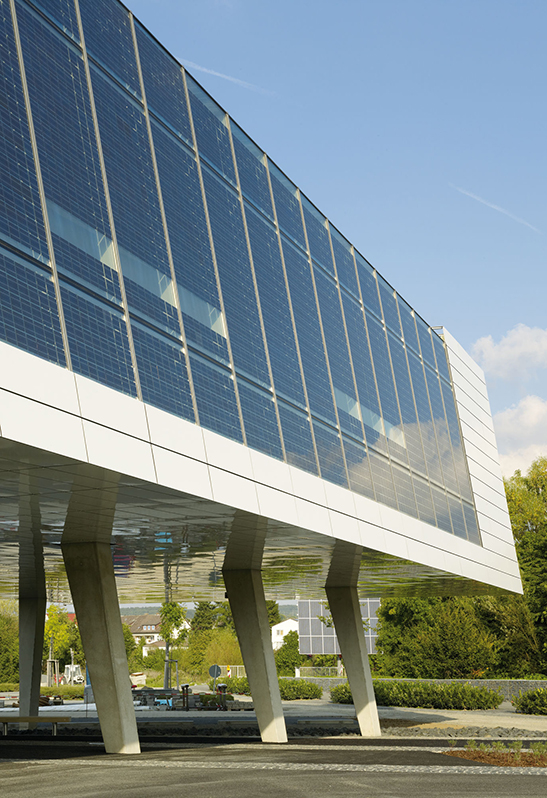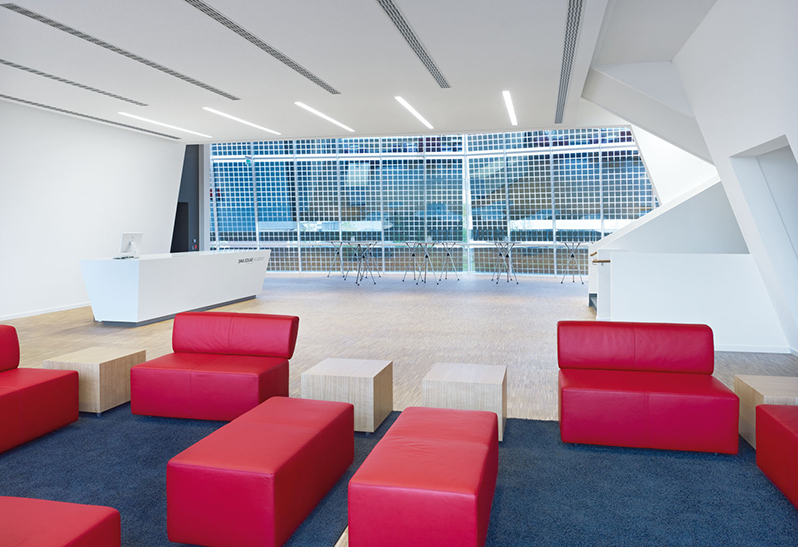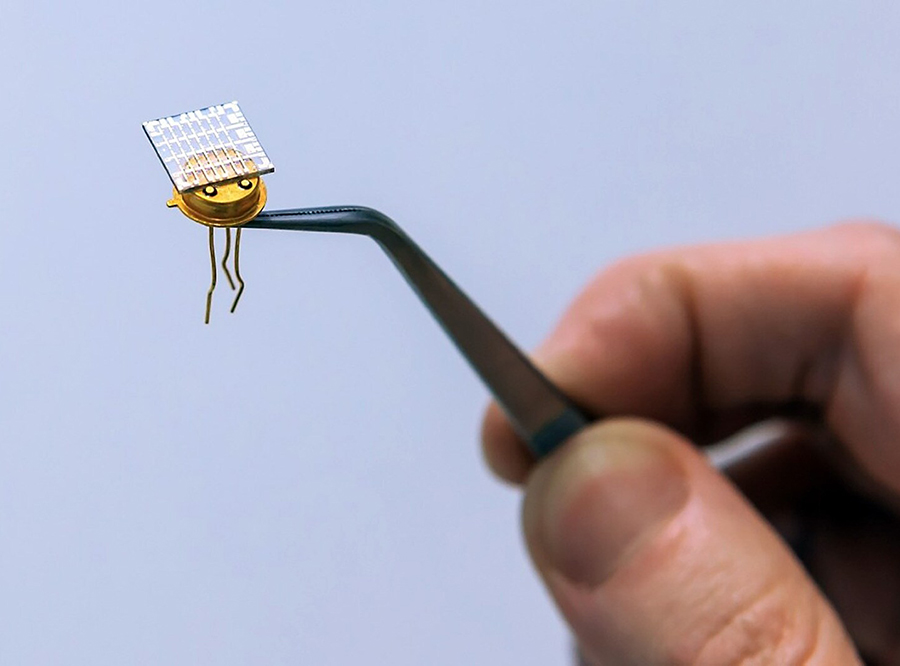A Crystal-Clear View with Green Added Value

Window glass has been around for over 2000 years. It is as old as it is practical: On the façade of a building, it lets light in. Windows can be opened to let in fresh air. Depending on the season, they can keep the warmth in or the heat out. Modern-day architects love to clad buildings in glass. Iconic skyscrapers such as The Shard in London, the Burj Khalifa in Dubai or the new World Trade Center in New York are just three impressive examples. Window glass is about to gain a new and highly practical function: clean energy generation.
Shadow of the sun
Fourteen years ago, the Günther Cramer Solar Academy run by SMA Solar Technology AG demonstrated that building-integrated photovoltaics are also viable for window surfaces. The building, which is turned toward the light, is located close to the company headquarters in Niestetal and is a source of both knowledge and energy. When it was completed in 2010, the Solar Academy was not only a climate-neutral and energy self-sufficient building but also one of the world’s first off-grid systems. And for SMA, it has always been the best proof “that an autonomous, reliable and environmentally friendly electricity supply is possible – even in Niestetal, which is not exactly spoiled with sunshine,” says Dr. Tillmann Blume, Head of the SMA Solar Academy.

Numerous solar wafers on the roof and in the almost completely glazed southern façade of the building supply the Solar Academy with solar power. “These wafers are the basic building blocks of solar cells. They are embedded between the double-glazed windows and cast an impressive and deliberate play of shadows, which also helps to cool the building on sunny days,” says Blume. Together with numerous PV modules on the roof, the Solar Academy generates 90 kW of peak solar power, covering more than half of the building’s energy requirements. The Academy is simultaneously a showcase project for modern solar architecture and was awarded, among other things, the German Solar Prize in 2013.

Solar window seeks frame
Over a decade later, the dream of power-generating window glass is more realistic than ever. Intensive and successful research into the transparent solar cell is currently under way, with the USA, Germany and South Korea in particular engaged in a technological race with different approaches.
Among these is the world-renowned Massachusetts Institute of Technology – better known by its acronym MIT. A research project gave rise to not only the company Ubiquitous Energy but also to a solar window prototype. At first glance, it looks no different from normal window glass, but the ingenuity lies in the frame, which contains solar cells that convert UV light to green energy. To ensure that the light reaches the frame, Ubiquitous Energy has enhanced and refined an effect that we’re already familiar with: low emissivity (“low E”). This involves a wafer-thin metal layer that is applied to the glass and filters out parts of the light spectrum to keep buildings warmer in winter and cooler in summer. The optimised low-E version is designed „to absorb only the ultraviolet and near-infrared wavelengths,“ explains Richard Lunt, Professor of Chemical Processes and Materials Science at Michigan State University and co-founder of the start-up. The UV and infrared radiation is channelled into the frame, where it is converted into green energy.
This means that buildings with large glass façades could become vertical solar farms in the future and cover at least their own energy requirements. The company’s own headquarters shows that this idea works. The approximately 10 m² solar window façade generates enough electricity to power the LED ceiling lighting in the conference room. However, the path to a commercial breakthrough is full of challenges. For starters, the solar windows cost a third more than conventional windows. Then there is the low energy yield of the solar cells. With an efficiency of just 5%, they lag far behind the efficiency of conventional solar cells. Finally, the question of how the electricity can be effectively distributed – or tapped directly at the window using blinds and sensors – also remains unanswered. The American startup wants to present a lucrative version for the mass market in just a few years.
Transparent solar cells
Researchers at Leipzig University are already a decisive step closer to the dream of solar windows. Solid-state and semiconductor physicist Professor Marius Grundmann and his team unveiled the world’s first transparent solar cell in 2016. Instead of being made of silicon, which is usually the case, it is made of nickel and zinc oxides, which are more conductive. The cell converts UV light directly to energy, but its efficiency is currently just 4% – so too low to be a serious and reliable proposition. But it is possible to increase the yield because the ultraviolet range of the light spectrum is extremely high-energy. But according to Grundmann, no one is willing right now to put the concept into practice on an industrial scale, mainly due to the low cost–benefit ratio.
 Swen Reichhold Universität Leipzig
Swen Reichhold Universität LeipzigA research team at Incheon National University on the northwest coast of South Korea is pursuing a similar approach. The transparent solar cell developed here consists of titanium and nickel oxide. Semiconductors are applied to the glass substrate, which actually makes conventional solar cells opaque. While the prototype attained an efficiency level of just 2.1%, it was capable of generating energy in low-light conditions. The researchers are working on ways to boost efficiency. Meanwhile, a completely different idea is very popular on the south-east coast. The Ulsan National Institute of Science and Technology is relying on optical illusions. The researchers drilled several micro-holes with a diameter of 100 micrometers – about the size of a human hair – into conventional non-transparent silicon solar cells. The pattern created by the thousands of holes is invisible to the human eye, which means that the solar cell appears transparent. Thanks to this optical illusion, the solar cells achieve an astonishingly high efficiency of 12%. In addition, the industrial manufacturing process for the drilled solar cells would be similar to that for conventional solar cells, so hopes for a commercial breakthrough of the solar window are high.
 Joule
JouleThe technology race
Whether thanks to metal layers, metal oxides, semiconductors or optical illusions, solar windows could become a profitable reality in the coming years. The success or failure of the technology depends on the level of efficiency achieved. This requires not only further research but also a willingness on the part of the industry. In addition, a few questions remain unanswered: How can the electricity generated be efficiently distributed? How much will the material discolor after years of exposure to sunlight? The most important thing is that the windows remain transparent. When it comes to the energy transition, conventional solar cells are currently still cheaper and more reliable, even if they cannot be installed everywhere. But if skyscrapers and glass façades really do one day become economically viable vertical solar farms, they will make an important contribution to the energy and building transition.


